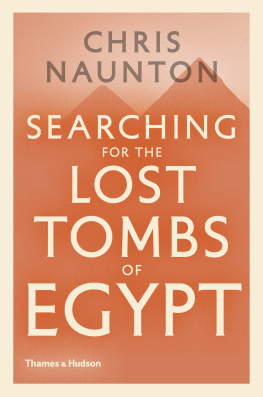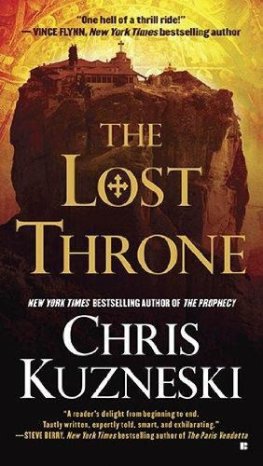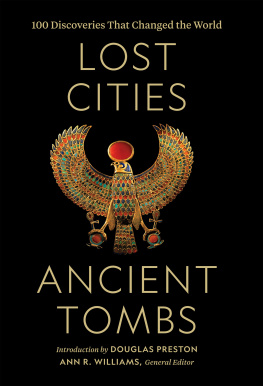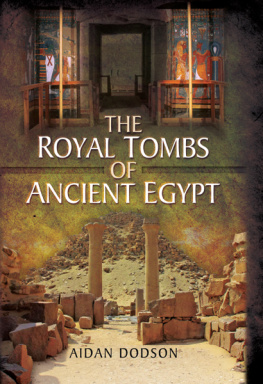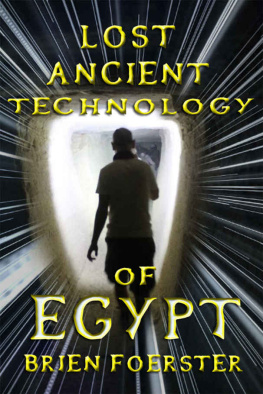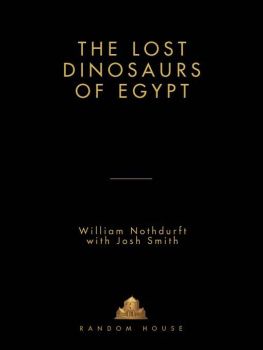Chris Naunton - Searching for the Lost Tombs of Egypt
Here you can read online Chris Naunton - Searching for the Lost Tombs of Egypt full text of the book (entire story) in english for free. Download pdf and epub, get meaning, cover and reviews about this ebook. year: 2018, publisher: Thames & Hudson, genre: Religion. Description of the work, (preface) as well as reviews are available. Best literature library LitArk.com created for fans of good reading and offers a wide selection of genres:
Romance novel
Science fiction
Adventure
Detective
Science
History
Home and family
Prose
Art
Politics
Computer
Non-fiction
Religion
Business
Children
Humor
Choose a favorite category and find really read worthwhile books. Enjoy immersion in the world of imagination, feel the emotions of the characters or learn something new for yourself, make an fascinating discovery.
- Book:Searching for the Lost Tombs of Egypt
- Author:
- Publisher:Thames & Hudson
- Genre:
- Year:2018
- Rating:4 / 5
- Favourites:Add to favourites
- Your mark:
- 80
- 1
- 2
- 3
- 4
- 5
Searching for the Lost Tombs of Egypt: summary, description and annotation
We offer to read an annotation, description, summary or preface (depends on what the author of the book "Searching for the Lost Tombs of Egypt" wrote himself). If you haven't found the necessary information about the book — write in the comments, we will try to find it.
Searching for the Lost Tombs of Egypt — read online for free the complete book (whole text) full work
Below is the text of the book, divided by pages. System saving the place of the last page read, allows you to conveniently read the book "Searching for the Lost Tombs of Egypt" online for free, without having to search again every time where you left off. Put a bookmark, and you can go to the page where you finished reading at any time.
Font size:
Interval:
Bookmark:



Frontispiece: One of the colossal statues of Akhenaten discovered at Karnak and now on display in the Luxor Museum.

For my Dad, and in memory of my Mum
Thames & Hudson include:
Giza and the Pyramids
The Complete Temples of Ancient Egypt
The Complete Cities of Ancient Egypt
See our websites
www.thamesandhudson.com
www.thamesandhudsonusa.com

The tombs, mummies and spectacular grave-goods that have emerged from the sands of Egypt have come to define what Egyptology means to most people. This is a story about ancient Egypt, and what happened when people in that part of the world, thousands of years ago, died. Its about their belief in an afterlife, and how they buried their dead. Its well known that for the wealthiest and most important members of that society, and particularly for the man at the top pharaoh himself funerary preparations were very extensive, and at times this meant constructing elaborate, beautifully decorated and cleverly secured tombs to receive the remains of the dead.
Almost as captivating as the ancient ruins themselves are the stories of their rediscovery the exploits of a huge cast of explorers, archaeologists, robbers and others who have sought out these tombs, motivated variously by the desire to understand the ancient past, to uncover works of art for people to look at in museums, or just to make a fast buck by discovering rare and beautiful treasures.
In particular, this is the story of a series of tombs that belonged to some of the most famous individuals in the ancient world: Imhotep, Nefertiti, Alexander the Great, Cleopatra and others. Their names have survived in the texts, in hieroglyphs and other scripts and languages, left on the walls of temples and the tombs of their contemporaries, on papyri and other artefacts, and in the historical accounts composed by classical and later writers. The possibility of rediscovering the last resting places of these ancient celebrities, and perhaps even their mortal remains, has inspired many an archaeologist or historian to set out on an expedition to the ruin-rich deserts of Egypt. This is the story of those archaeologists quests, and an examination of the possibility that some of the tombs in question might yet be found.
The ancient Egyptians have acquired a reputation for being obsessed with death, but its probably undeserved, and as much about the kinds of archaeological evidence that have survived and how they have been interpreted as an accurate reflection of past preoccupations.
Western interest in Egypts ancient past began to accelerate in the 19th century, following Napoleons invasion of the country in 1798. At that time many ancient monuments were half buried in drift sand, or overtaken by more modern buildings that had sprung up in and around them, but they were nonetheless very visible. The team of scholars and scientists who accompanied the Napoleonic expedition produced a detailed record of its ancient monuments, a series of volumes published as the Description de lgypte between 1809 and 1829. Antiquities had already begun to leave the country by this point; by the time the British Museum opened in 1753, around 150 of the objects in its collection were Egyptian. As interest in acquiring such objects among the elite and those collecting on behalf of museums began to grow, excavations uncovered new sites and monuments. Among the most famous of the early Western excavators was Giovanni Battista Belzoni, an Italian who, following a career as a circus strongman, came to work for the British Consul General in Egypt, Henry Salt. Belzoni was among the first to begin digging and made some spectacular early discoveries, including the tomb of Sety I in the Valley of the Kings, and was also the first in modern times to enter the second pyramid, of Pharaoh Khafre, at Giza.
Cemeteries, and the tombs within them, tended to yield antiquities of the most spectacular kind and quantity, and so naturally attracted the most attention. It was immediately clear that the ancient Egyptians believed strongly in an afterlife, and were very concerned to ensure that they got there, through a complex system of beliefs and rituals that, crucially for modern collectors, involved material possessions. The passage of the deceased from this world to the next was conceived as a journey, and the list of provisions with which the dead could be equipped seems to have been almost infinite, and was for most probably only limited by their financial wherewithal and that of their relatives. But most fundamentally of all, a place needed to be found to bury the body for those who could afford it, an elaborate tomb.
The earliest burials in Egypt, during the Predynastic Period, were little more than shallow pits, covered with a mound of sand, into which the body of the deceased, wrapped in goatskins or mats, was placed along with various possessions typically pottery vessels, ivory or bone combs, slate palettes and sometimes ceramic figurines. Over time, tombs began to take on a more formal, rectangular shape, the number of items placed alongside the body increased, and the finest examples came to be lined with mudbrick, and occasionally divided into two chambers. The tombs of the kings of the 1st Dynasty are found at Abydos, in Middle Egypt. These were square, brick-lined cuttings in the desert floor, in which a central chamber of wood was constructed. This chamber was surrounded on three sides by storage magazines. It is unclear what lay above these tombs, although a low mound seems likely, and the location of each tomb was marked by two stone stelae bearing the name of the deceased king.
The highest-status burials became larger and more elaborate over time. The number of chambers and provision of funerary equipment increased, and superstructures evolved into straight large rectangular structures, built of mudbrick, sometimes reaching 10 m (33 ft) in height. These superstructures are known as mastabas (an Arabic word for the kind of wooden bench typically found in or outside Egyptian houses), and while many are simply filled with rubble, they sometimes housed chambers in addition to any subterranean compartments containing burial equipment, and often incorporated chapels on the exterior in which the bereaved could place offerings to the deceased.
At the beginning of the 3rd Dynasty, a crucial step was taken in the development of royal funerary architecture: the subterranean tomb of the first king of the line, Djoser, was surmounted by a square-based platform, on top of which a sequence of further platforms of diminishing size was placed, creating a stepped structure. This was the Step Pyramid, the first example of the triangular building that defines ancient Egypt more than any other. The structure was also revolutionary in being the first monumental structure built of stone anywhere in the world. The Step Pyramid was part of a wider complex of buildings within a vast enclosure, providing not only for the burial of the king but also the maintenance of his cult beyond the end of his life, sustaining his spirit in the afterlife. His successors were to innovate and experiment almost constantly with this type of monument, as their chief architects and builders strove to create larger and more perfect true pyramids, culminating eventually in the reign of the 4th Dynasty king Khufu with the largest pyramid of all, the Great Pyramid at Giza.
Font size:
Interval:
Bookmark:
Similar books «Searching for the Lost Tombs of Egypt»
Look at similar books to Searching for the Lost Tombs of Egypt. We have selected literature similar in name and meaning in the hope of providing readers with more options to find new, interesting, not yet read works.
Discussion, reviews of the book Searching for the Lost Tombs of Egypt and just readers' own opinions. Leave your comments, write what you think about the work, its meaning or the main characters. Specify what exactly you liked and what you didn't like, and why you think so.

